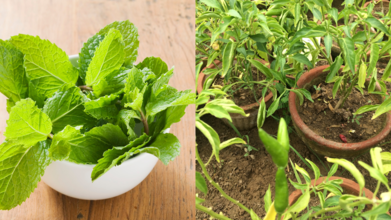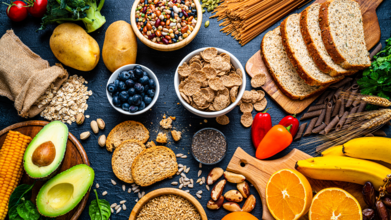- Health Conditions A-Z
- Health & Wellness
- Nutrition
- Fitness
- Health News
- Ayurveda
- Videos
- Medicine A-Z
- Parenting
- Web Stories
An Apple A Day Does Keep The Doctor Away! Here’s Why We Eat Apple To Lower Cholesterol

Apples fpr Cholesterol (Credit-Canva)
We all know the phrase that ‘An apple a day keeps a doctor away’ but there may be some truth to it! Apples are quite common for North American diets, so much so that it is one of the top-ranking foods by them. While it is true that this popularity is because of how affordable this fruit is, but beyond how good it tastes, apples are known to have a lot of nutrients that contribute to overall well-being, particularly heart health. They are not only a good source of essential vitamins, minerals, and antioxidants, but these elements also help you keep your cardiovascular function in check. With the cost of food rising day by day, making healthy food more unaffordable for people, apples being affordable and a great source of nutrition is a big deal! These make it a lot less likely for people to rely on medicine to cure their issues. This versatile fruit can be enjoyed in many ways, while there are desserts you can add the fruit to, there are many healthy smoothies and drinks that are made better when you add the fibrous fruit to it.
What makes Apple So Healthy For Cholesterol?
Scientists have done studies on both animals and people that show how pectin helps with cholesterol. Animal studies have found that pectin can lower total and LDL cholesterol. Studies with people have shown similar results, when people eat foods with pectin, their LDL cholesterol goes down. These studies show that pectin can really help lower cholesterol naturally and that eating apples is a good way to get it.
Eating apples regularly can help manage your cholesterol, even if they won't completely fix very high cholesterol on their own. Eating an apple every day gives you a steady supply of pectin and other good nutrients. This helps keep your cholesterol at a healthy level and lowers your risk of heart problems. Remember that eating apples works best when combined with other healthy habits like a good diet and exercise. They're an easy and tasty way to support your heart health over time.
How Does This Help Postmenopausal Women?
After menopause, women often see their cholesterol levels go up because of hormone changes. Studies show that apples can be especially helpful for these women. Regular apple consumption has been shown to lower both total and LDL cholesterol in postmenopausal women. This means apples can be a great way for these women to manage their cholesterol naturally. The studies also suggest that the longer you eat apples regularly, the better the results for your cholesterol. Here are some healthy foods you can incorporate apple into.
Overnight Oats with Apple and Cinnamon
Combine rolled oats, milk (dairy or non-dairy), Greek yogurt (optional, for extra protein), chopped apple, cinnamon, and a touch of honey or maple syrup in a jar. Refrigerate overnight and enjoy cold in the morning. This is a great make-ahead breakfast that's packed with fiber and protein.
Apple Cinnamon Baked Oatmeal
A warm and comforting breakfast option. Combine oats, milk, eggs, chopped apple, cinnamon, and other spices like nutmeg and ginger. Bake until set. You can add nuts or seeds for extra texture and nutrition.
Apple and Peanut Butter Toast
A simple yet satisfying breakfast or snack. Toast whole-wheat bread and spread with natural peanut butter. Top with thinly sliced apple and a sprinkle of cinnamon.
Homegrown Metabolism: Why These Tiny Plants Pack a Big Health Punch

If you’ve ever thought that boosting metabolism requires protein powders, extreme diets or fancy gym routines, think again. According to experts, your metabolism could benefit more from a pot of mint on your kitchen window than a supplement in your cabinet. And you can also grow it yourself.
Your Backyard is a Bioactive Goldmine
“Boosting your metabolism naturally isn’t about chasing quick fixes,” says Maninder Singh Nayyar, Founder, CEF Group. “It is about giving your body the kind of nourishment that helps it convert food into energy more efficiently.”
He explains that many metabolism-friendly foods can actually be cultivated at home. “Moringa, mint, lemongrass, curry leaves, green chillies, turmeric, and microgreens are all rich in antioxidants and bioactive compounds that help reduce inflammation, balance hormones, and support the body’s natural fat-burning ability.”
Spices and Herbs that Work Behind the Scenes
Each ingredient brings its own superpower to the table. “Take mint, for example, it helps improve bile flow and relaxes the stomach muscles, which supports digestion and better nutrient absorption, both key to a healthy metabolism,” says Nayyar, referencing insights from Sova Health.
Green chillies, he adds, are fiery for a reason. “They contain capsaicin, known to increase the body’s heat production and energy use, while turmeric helps enhance insulin sensitivity and brings down inflammation, both of which benefit metabolic health over time,” he says.
The Power of Growing Your Own
“Growing these ingredients at home, whether it’s a pot of mint on your windowsill or a few microgreens in your kitchen, adds an extra layer of freshness and trust to your meals,” Nayyar explains. “It also creates a stronger connection with what you eat.”
Urban farming, he says, is more than a trend. It’s becoming a practical solution. “Studies show that urban farming can increase access to fresh produce by up to 30% in cities, and it plays a growing role in tackling nutrition and sustainability challenges in densely populated areas.”
Nutrition Straight from the Soil
Payal Sharma, Senior Nutritionist and Dietician at Dharamshila Narayana Superspeciality Hospital, Delhi, says, “Optimising the body's metabolic function is fundamentally about providing it with the right raw materials, and home-grown foods offer an exceptional source.” This isn't about fleeting fads; it's about harnessing the inherent power of nutrient-dense produce to enhance our natural energy conversion processes.
She elaborates on how these natural ingredients work. “When we cultivate ingredients like moringa, mint, lemongrass, curry leaves, green chillies, turmeric, and microgreens, we're tapping into a rich pharmacy of bioactive compounds and antioxidants.”
It’s not just about individual ingredients either. “Capsaicin in green chillies is well-documented for its ability to induce thermogenesis, gently increasing the body's caloric expenditure. Similarly, turmeric's potent curcuminoids play a vital role in reducing systemic inflammation and improving insulin sensitivity, critical factors in how effectively our bodies utilise glucose for energy.”
From Garden to Gut
According to Sharma, the freshness of just-harvested herbs and greens makes all the difference. “The unparalleled freshness and vibrant nutrient profile of just-harvested produce ensure that these beneficial compounds are delivered in their most potent form. This direct link from garden to plate not only maximises nutritional intake but also fosters a deeper, more mindful relationship with food, empowering individuals to truly fuel their metabolism from the ground up.”
Another Day, Another Trend: What Is Fibermaxxing and What Are The Experts Saying About It?

TikTok’s health trends never seem to stop, and the latest one is fibermaxxing, a catchy name for something dietitians have already been preaching for years: eat your fibre. While the trend may sound like a clever hashtag, it has got people munching on lentils, oats, berries and veggies like never before. But is this just another health fad? We find out.
What Is Fibermaxxing?
Simply put, fibermaxxing is all about loading up your plate with fibre-rich foods. They include chickpeas, whole grains, flax seeds, fruit skins and all those leafy greens you keep ignoring. The term originated, like every other term, on TikTok, where creators began sharing fibre-loaded meals and showing off their impressive digestive health wins.
The hashtag #fibermaxxing took off in 2023 and has since drawn millions of views. Behind the scenes, the goal of this trend is fairly wholesome: to encourage people to meet their daily recommended fibre intake.
Why Experts Say It is Actually a Good Idea but in Moderation
Fibre has always been a nutritionist's favourite. Health experts have been saying it forever: getting enough fibre every day can seriously boost your overall health. It helps keep your digestion on track, keeps your blood sugar steady, and even brings down cholesterol levels. On top of all that, it has been linked to a lower risk of heart disease, type 2 diabetes, and some cancers.
Plus, fibre keeps you feeling full for longer, which means fewer snack attacks and better weight management without trying too hard.
How Much Fibre is Too Much Fibre?
As with most TikTok trends, the issue is not the idea but the excess. Experts caution that suddenly jumping on the fibermaxxing trend without building up gradually can lead to bloating, gas, constipation, or the dreaded combination of all three.
Fibre draws water into the digestive tract and bulks up stool, which is great, but only if your body is used to it and you are drinking enough fluids. Adding too much too soon can overwhelm your gut and leave you feeling worse, not better.
If your stomach tends to be on the sensitive side or you have something like IBS, suddenly flooding your system with a ton of fibre can actually make things worse. Instead of feeling lighter and healthier, you might end up feeling gassy, bloated or straight-up uncomfortable. So while this trend is all about gut health, jumping in too fast can totally backfire.
How to Fibremaxx Without Wrecking Your Stomach
- Take it slow: Do not shock your system. Add a little more fibre to your meals every few days so your gut has time to catch up.
- Hydrate like a champ: Fibre needs water to do its thing. If you are not drinking enough, you could end up feeling more blocked than balanced.
- Stick to real food: Go for natural, whole sources like fruits with the skin, veggies, lentils, oats, brown rice, nuts, and whole grain everything.
- Mix your fibre types: Soluble fibre like oats, apples and flaxseeds helps with digestion, while insoluble fibre like leafy greens and whole grains keeps things moving.
- Do not go overboard: A giant portion of lentils might look cool in a reel, but your stomach might not agree. Keep it balanced.
Easy Ways to Add More Fibre
- Swap white rice for brown or red rice
- Sprinkle chia or flaxseeds on your yoghurt
- Stir lentils into your soups, dals, or pasta sauces
- Munch on roasted chickpeas or a handful of almonds
- Do not peel your apples or cucumbers
- Start your day with oats or a whole grain cereal
Heart Healthy And Lowers Blood Pressure - This Colorful Vegetable Is Your Answer To A Healthy Future

(Credit-Canva)
Known as a silent killer, high blood pressure is a much more common issue than we believe. It is a condition where the blood pushes against your artery walls, creating pressure. It not only increases the chances of heart disease and strokes but was a contributing cause of 664,470 deaths in the US, according to the Centers of Disease Control and Prevention. So how does one tackle this issue?
New research suggests that drinking a bit of vegetable juice every day might help older folks lower their blood pressure. Beetroot juice is especially good because it has a lot of something called nitrate. Nitrate is important for how our bodies work and has been linked to lower blood pressure and healthier blood vessels.
How Beetroot Juice Might Work: A Mouth-Body Connection
Researchers at the University of Exeter believe that beetroot juice's positive effects on heart health could be due to changes it makes to the bacteria in your mouth.
In their study, participants drank either regular beetroot juice (full of nitrate) or a placebo drink (with nitrate removed). When people drank nitrate-rich beetroot juice, tests showed a decrease in certain mouth bacteria called Prevotella and an increase in beneficial bacteria like Neisseria.
Notably, older participants in the study started with higher blood pressure on average. Their blood pressure went down after drinking the nitrate-rich beetroot juice, but not when they drank the placebo.
Science Behind Why It Helps
One of the researchers explained that this study shows how foods rich in nitrate can change the tiny organisms in our mouths. These changes could then lead to less swelling (inflammation) in the body and help to lower blood pressure in older people. This discovery is exciting because it opens the door for bigger studies to look more closely at how things like what we eat, and even if someone is male or female, affect how their body reacts to getting more nitrate from their diet. It helps us understand the hidden ways food can impact our health.
What the Study Found
The study involved two groups of adults: one group of 39 younger people (under 30 years old) and another group of 36 older people (in their 60s and 70s). Each person in the study tried both the real beetroot juice and the fake juice for two weeks at a time. The researchers observed that the changes in mouth bacteria happened in both the younger and older groups. However, the drop in blood pressure was only seen in the older participants.
Another researcher from the study mentioned that we already know that eating foods rich in nitrate is good for our health. She also pointed out that as people get older, their bodies naturally produce less of something called nitric oxide, which is important for blood vessels. Older adults also tend to have higher blood pressure, and high blood pressure can lead to serious heart problems like heart attacks and strokes. So, encouraging older adults to eat more vegetables with nitrate could offer really significant and lasting health benefits.
© 2024 Bennett, Coleman & Company Limited

